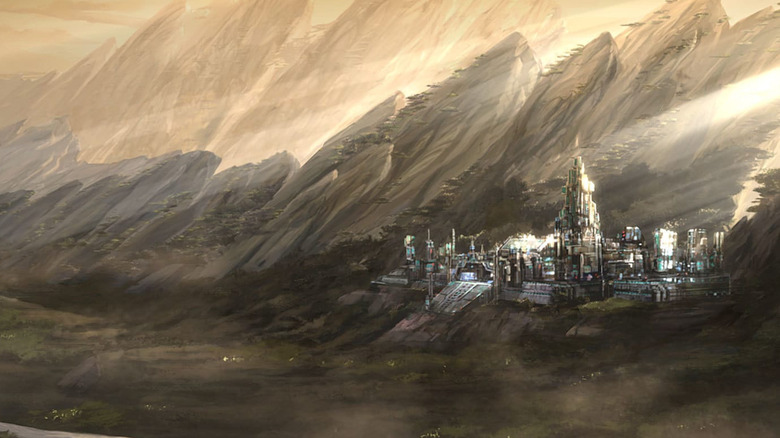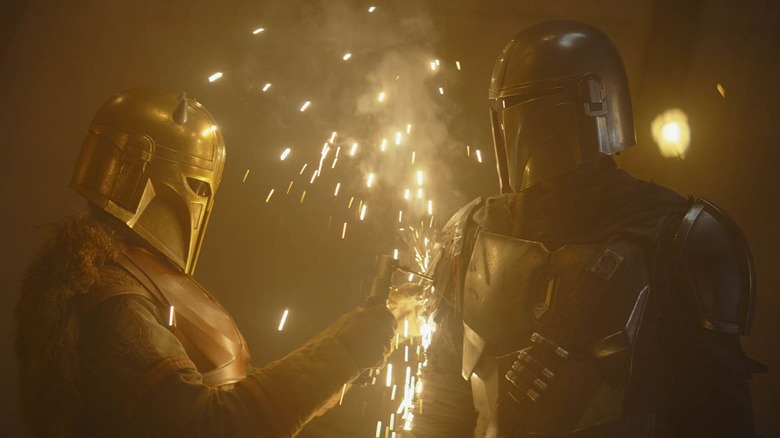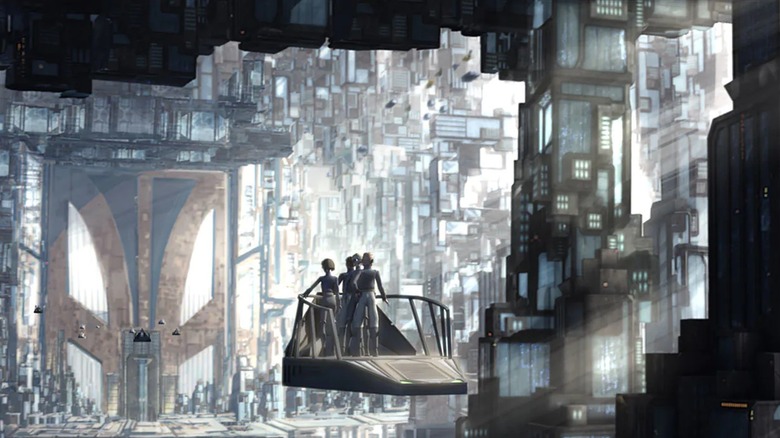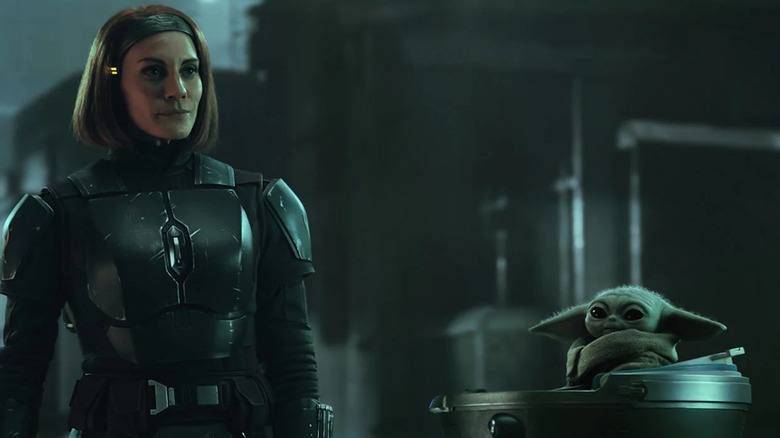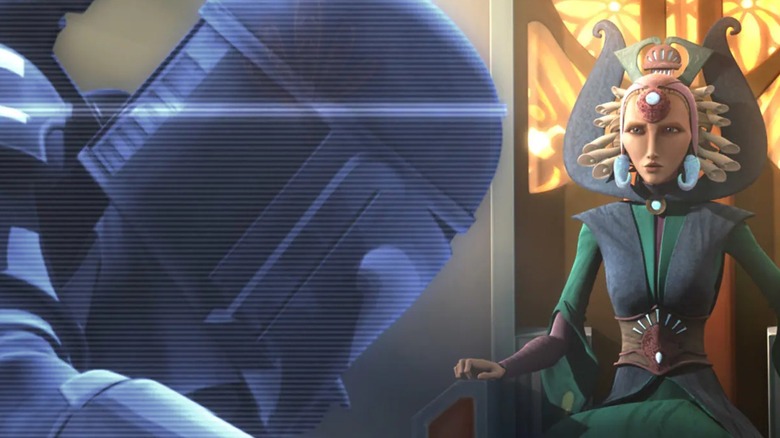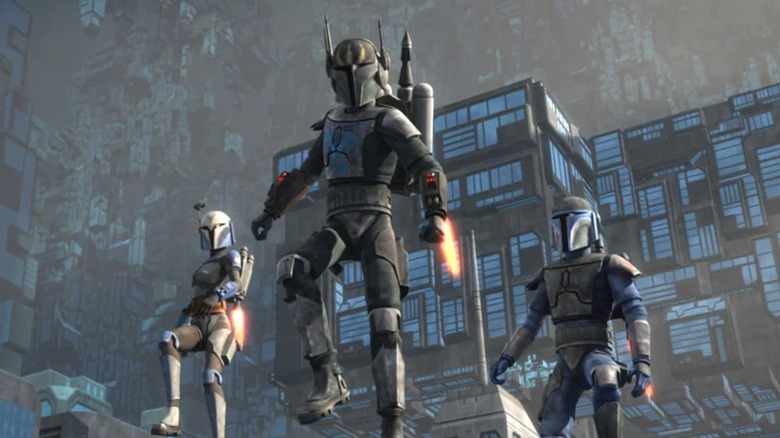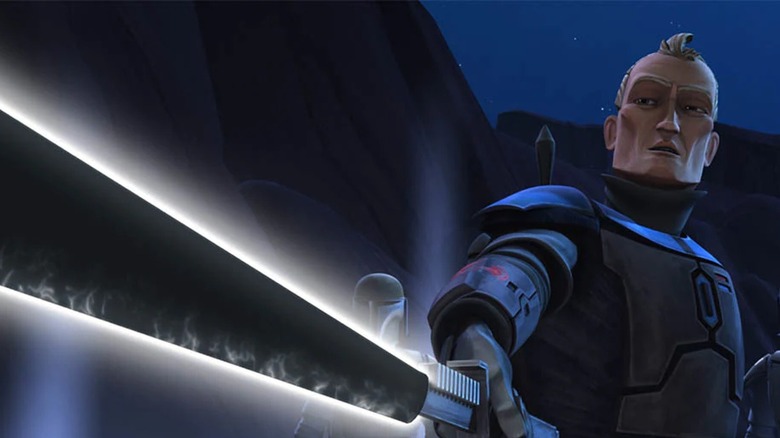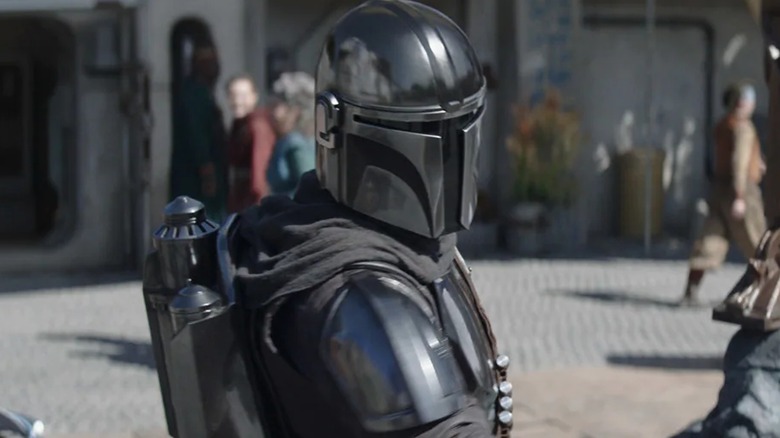The Entire History Behind Concordia Only Huge Star Wars Fans Will Know
One of the most enticing elements in the hype ahead of the third season of Disney+'s "The Mandalorian" was the tease that we would finally get to see Mandalore, Din Djarin's home planet. With Djarin denounced as an apostate by fellow Mandalorian Paz Vizsla in "The Book of Boba Fett," the Tribe's leader, the Armorer, tasked him with touching the water found in the mines of Mandalore in order to regain his status as a devoted Mandalorian. With the planet having thus far appeared in live-action form only via flashback in "The Book of Boba Fett," this underexplored corner of the "Star Wars" universe has been dying for expansion since the Mandalorians were first mentioned in noncanonical comic history via "Star Wars" #68 in 1983.
As we've gotten to know Djarin better since his debut in the first episode of the series, his origins have taken a backseat to the fast-paced action of the post-"Return of the Jedi" timeline. Djarin was rescued by the Tribe, an offshoot of an extremist group of Mandalorians known as Children of the Watch, after his family was killed. He soon adopted their creed, but for now, further details remain obscure. The second episode of the third season of "The Mandalorian" lets us in on the detail that Djarin actually hails from Concordia, a moon of Mandalore, rather than the main planet itself. For fans of "The Clone Wars," the name will be familiar for the role it played in its second season episode, "The Mandalore Plot." Even at that, we have only sparse information about Concordia, leaving fans wondering whether the moon is going to make a major appearance on the show.
We only kind of know what it looks like
While we've gotten a few hints along the way, we still have a lot of questions as to exactly what Concordia looks like, including its size and overall habitability. In "The Mandalore Plot," we learn that Obi-Wan believes Concordia to be a simple agricultural settlement. The beneficial Mandalorian leader Satine Kryze informs him that, before the end of the Mandalorian-Jedi Wars, it was turned into a mining base, depleting resources and wrecking the landscape of the moon. We are told that the forests are only just starting to bounce back from ecological devastation after having been abandoned and given the time to heal. This is more than can be said for Mandalore, which is mostly barren.
While Mandalore's mines are deep and difficult to reach, Concordia's are much closer to the surface, hinting as to why it may have been regulated to status as a mining site. On Mandalore and Concordia alike, the mines hold Beskar, or "Mandalorian iron," the metal that makes up the Mandalorian's armor, a highly sought-after natural resource. Besides the lush forests and vegetation that grows on Concordia, what we've heard so far is that it has a mountainous terrain. A huge difference between Mandalore and Concordia lies in Concordia's lack of domes over its main city, which are a requirement for survival on Mandalore due to the ravages of the many wars that have long plagued the planet.
Concordia isn't Mandalore's only moon
Concordia isn't Mandalore's only moon. According to the 2009 galactic "Star Wars" reference book, "The Essential Atlas" by Jason Fry and Daniel Wallace, Mandalore actually has two moons. As of yet, there is little known about the other, with even official sources referring to it only as "Mandalore's second moon." According to the atlas, it revolves around Mandalore much the same way Mandalore revolves around its sun, and that's about all we can say for sure about this unexplained rock.
With even less information to draw from regarding "Mandalore's second moon" than we have from its sparsely explored "first moon," it's difficult to say if we'll be seeing it up close and personal anytime soon. While Concordia and Mandalore have some clear-cut similarities and differences, we have no indication of what the terrain on the second moon is like, whether or not it's habitable, or what role it may have played in the famed Mandalorian-Jedi Wars. Still, even with so little to go from, one thing we can say for sure is that "Star Wars" mythos has a way of eventually catching up to itself. Just because we haven't heard much about this moon doesn't mean there aren't galaxy-shattering revelations in store.
Like Mandalore, Concordia is primarily inhabited by humans
According to "The History of the Mandalorians" feature in "Star Wars Insider," in the beginning, the Mandalore System was occupied primarily by green scaly creatures known as the Mandallian Giants. However, the planet was eventually occupied by the simian Taung people, whose home world was the galaxy capital of Coruscant. Their leader, Mandalore the First, became the person after whom the planet would be named. However, we learn in "The Mandalore Plot" that, over time, the planet came to be primarily occupied by humans. Though the population has shifted over the years, in "The Essential Atlas," we're told that Mandalore has a population of roughly four million, while Concordia only has a little over 400,000.
In part due to the decree that Mandalorians shall never remove their masks in plain view of others, it's hard to say which Mandalorians are human and which aren't. We saw Djarin's face in the first season when he was forced to seek assistance from the IG-11 droid. Additionally, as of last season, Djarin let the unmasking rule fly out the window due to necessity, and it's led to a whole heap of new problems in both "The Book of Boba Fett" and the third season of "The Mandalorian." For now, we know through visual cues that some Mandalorians we've met so far, like Djarin and Jango Fett, are human.
Concordian is its own language
The primary language of Mandalore is Mando'a, but it seems that the people of Concordia may very well have their own dialect. We first see canonical traces of this in "The Clone Wars" when a suicide bomber affiliated with the terrorist faction Death Watch attempts to destroy the Memorial Shrine of the Mandalorian city of Sundari. After the attack, Obi-Wan tries to bring the bomber in, but he dies, uttering the phrase, "Calhava bru'chun dralshye'ran!" which has been unofficially translated roughly to mean, "Compassionate leaders will burn!" This shrine, meant to honor those who died during the bloody Mandalorian Civil War, was left in its broken state on the order of Satine Kryze to warn against pointless violence, though the ruins were ultimately removed. Thus, this seems to be a fitting quote to sum up many of the episode's themes.
However, this translation has yet to be officially confirmed. With the phrase apparently first appearing via an Empire At War forum in 2007 that today only exists via the magic of website archiving, the jury is still out whether this can be considered canonical. Likewise, "Star Wars Insider" ran a feature called "Guide to the Grand Army of the Republic," written by Karen Traviss and Ryan Kaufman in 2010. This feature introduced the concept of Concordian dialect, but is considered to be a part of the "Legends" continuity. This means that the factoid is not necessarily in keeping with the modern-day rule system of post-Disney "Star Wars," leaving a big question mark as to what exactly speaking "Concordian" actually entails.
Concordia's people are often at odds with those of Mandalore
If one thing defines the legend of Mandalore, it's that the planet has spent much of its history in a series of violent conflicts and wars that have led to planet-wide environmental repercussions. The mythical Mandalorian Wars lasted no fewer than 16 years, sparked by Mandalorian distrust of the Jedis, which they refer to as "sorcerers" as recently as the first season of "The Mandalorian." Though Mandalorian Tarre Vizsla eventually became a Jedi, this only occurred after a series of conflicts between the Jedi and the warriors of Mandalore. Even at that, as viewers of the "The Book of Boba Fett" will know, Vizsla's Darksaber has gone on to be a major source of strife for not just Djarin but also countless others.
Toward the end of the Mandalorian-Jedi Wars, Mandalore stripped Concordia for resources, leading to the devastation Satine Kryze mentions in "The Mandalore Plot." The Jedi won the war against the Mandalorians, but it left the planet with a scorched terrain and its remaining population living in protective domes. As if things couldn't get worse, the Mandalorian Civil Wars broke out, causing even more destruction. In response, Kryze and others formed a more peaceful group known as the New Mandalorians, devoting their lives to pacifism. Yet, further conflict between them and violent-prone traditionalists continued to cause tragedy. Despite the main planet's neutrality during The Clone Wars, the Mandalorians continued to war with one another, with the rebellious Death Watch hiding out on Concordia.
Pre Vizsla plays a huge role in Concordia's story
A descendant of Tarre Vizsla, Pre initially appears to be an ally of the New Mandalorians, serving faithfully as the governor of Concordia. However, with an increase in attacks on Mandalore setting Obi-Wan on edge, we soon discover that he is much more insidious than we thought. Serving as the leader of the traitorous Death Watch, Pre becomes a recurring villain in "The Clone Wars," seeking to bring Kryze's peaceful rein to an end in hopes of restoring Mandalore's warrior heritage. While using the abandoned mines of Concordia as his base of operations, he is found out by Obi-Wan Kenobi, leading the two to engage in a fight to the death.
Even wielding the Darksaber against the Jedi Master, Pre loses the fight, but he wisely chooses to flee and lives to fight another day. This allows him to eventually launch an assassination attempt against Satine, among various other plots and schemes. In his zeal to take up the ancient Mandalorian war against the Jedi once more, Pre eventually caused his own demise, but not before unleashing a series of catastrophic events that sees Darth Maul stepping into power on Mandalore. "Star Wars" fans will know that this is far from the last challenge the Vizsla bloodline would pose, with Paz playing a major role in "The Mandalorian" as well as "The Book of Boba Fett," openly challenging Djarin for the Darksaber.
Being from Concordia gives Mando a different perspective
As little as we know about Din Djarin and Concordia, Djarin seems to be just as in the dark as we are for the most part. The many crimes of Death Watch served to destabilize Mandalore once more during "The Clone Wars," ultimately leading to the Great Purge of Mandalore. This saw millions of Mandalorians die and the region further destroyed, with political groups splintering into small factions and retreating into hiding. One such group is the mysterious Children of the Watch, about which very little is known. As we learned from Bo-Katan, the complicated sister of Satine, the group is similar to Death Watch in that its base of operations is Concordia and it seeks to return Mandalore to its most violent extremes.
The Tribe features members of Children of the Watch, but Djarin is surprised when Bo-Katan refers to the Children as an extremist group of religious zealots, having not realized that there was anything that set the group apart from more mainstream Mandalorian beliefs. Though it's not fully confirmed, it seems to go without saying that the Children are an offshoot of Death Watch, particularly in context to the fact that an attack from Death Watch is what led Djarin to be adopted into the Tribe to begin with. There are plenty of questions around Concordia, but if anything, we take comfort in the fact that our hero Djarin seems to share our confusion.
